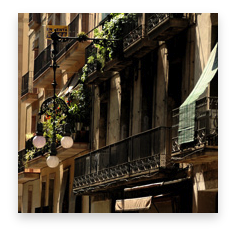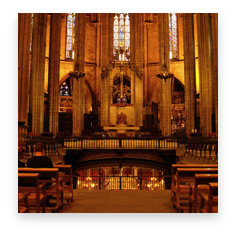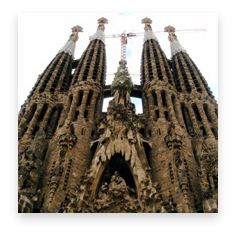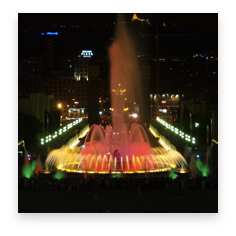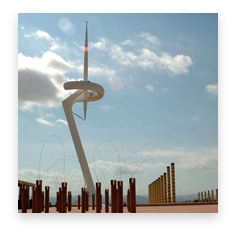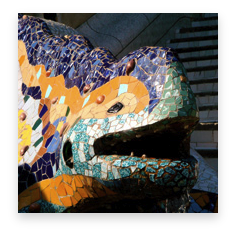Barcelona's old town - the Barri Gòtic
Barcelona's gothic district (the Barri Gòtic) is the area between the harbour, the famous Las Ramblas street and the Plaça de Catalunya and is full of history, amazing buildings, bustling squares, narrow streets and quite a unique feel.
The first tourist trap is Las Ramblas, which actually is five continuous streets. It's great in the dappled shade as it's full of life. Paintings are being drawn, street entertainment is everywhere, shops adorn each side, people sit and watch the world go by as you pass the aromas of flower stands. The amazing fruit, vegetable and fish market of San Josep stands on one side is an assault on the senses - the vibrancy of the colours and the shear selection of food is amazing.
Heading off to the Barri itself opens up a style, history and architecture which is truly beautiful. Long, meandering narrow streets radiate from large and small squares dominated by churches, cathedrals or important buildings. All along the area, the shops, restaurants, museums and buildings mean you can spend days just wandering, stopping for some tapas or just visiting the various sites recommended in the Rough Guide. It was a great tour guide to have at my fingertips as it really meant you understood the history and got to see all the sites. From traditional guitar music to Picasso, from street entertainers to church squares, this is one great starting point for a trip.
The first tourist trap is Las Ramblas, which actually is five continuous streets. It's great in the dappled shade as it's full of life. Paintings are being drawn, street entertainment is everywhere, shops adorn each side, people sit and watch the world go by as you pass the aromas of flower stands. The amazing fruit, vegetable and fish market of San Josep stands on one side is an assault on the senses - the vibrancy of the colours and the shear selection of food is amazing.
Heading off to the Barri itself opens up a style, history and architecture which is truly beautiful. Long, meandering narrow streets radiate from large and small squares dominated by churches, cathedrals or important buildings. All along the area, the shops, restaurants, museums and buildings mean you can spend days just wandering, stopping for some tapas or just visiting the various sites recommended in the Rough Guide. It was a great tour guide to have at my fingertips as it really meant you understood the history and got to see all the sites. From traditional guitar music to Picasso, from street entertainers to church squares, this is one great starting point for a trip.
Cathedral of Santa Eulalia (La Seu)
When you mention a famous church in Barcelona, almost everyone knows Gaudi's iconic Sagrada Familia church. But Barcelon's main cathedral is a wonderful place to visit and while dedicated to the co-patron saint of Barcelona, it's more commonly known by its Catalan name "La Seu" or in English, "The Seat". The cathedral is dedicated to Eulalia who according to tradition, suffered martyrdom during Roman times. One story is that she was exposed naked in the public square and a miraculous snowfall in mid-spring covered her nudity. The enraged Romans put her into a barrel with knives stuck into it and rolled it down a street (the one now called 'Baixada de Santa Eulalia'). The body of Saint Eulalia is entombed in the cathedral's crypt.
Because it's located in the Barri Gòtic, you can approach this cathedral from an amazing number of angles - from the imposing gothic front to the narrow-streets all around to the cloisters enclosing the 15th century Well of the Geese. On entering the cathedral, the cloisters is a peaceful area fully planted with small side chapels. The thirteen geese amble around amidst the tricking fountain in dappled shade.
The cathedral itself is spectacular. The columns just rise and rise upwards supporting the solid, dark roof. The lighting from the stained glass windows and internal lighting leads to a subdued golden hue which complements the gigantic space. While I've visited many spectacular cathedrals over the years, this one is a mix of ornate areas and rather simple areas which really add to its charm. While I've included quite a few photos, no photo can ever capture the size, scale, ambiance or just tranquility of the place.
Because it's located in the Barri Gòtic, you can approach this cathedral from an amazing number of angles - from the imposing gothic front to the narrow-streets all around to the cloisters enclosing the 15th century Well of the Geese. On entering the cathedral, the cloisters is a peaceful area fully planted with small side chapels. The thirteen geese amble around amidst the tricking fountain in dappled shade.
The cathedral itself is spectacular. The columns just rise and rise upwards supporting the solid, dark roof. The lighting from the stained glass windows and internal lighting leads to a subdued golden hue which complements the gigantic space. While I've visited many spectacular cathedrals over the years, this one is a mix of ornate areas and rather simple areas which really add to its charm. While I've included quite a few photos, no photo can ever capture the size, scale, ambiance or just tranquility of the place.
Eixample - Gaudí's La Pedrera (Casa Milà) and Sagrada Familia Church
Barcelona is made up of districts and there's a major contrast when you pass from the Barri Gòtic through the Plaça de Catalunya through into the Eixample area. Here mid-19th century wide boulevards criss-cross each other in a large grid and the architecture is very different. Eixample in catalan actually means "extension" which makes sense as the area was built to extend the old city outwards encompassing other towns in the process.
Some parts of the Eixample were influenced by Modernista architects, chief among whom was Antoni Gaudí. His work in the Eixample includes the Casa Milà (nicknamed La Pedrera - the Quarry) and the Casa Batlló, both of which are on the wide Passeig de Gràcia, as well as the Sagrada Família. Visiting the Pedrera is a great experience. It was built in 1906-1912 as a private house for Rosario Segimon and Pere Milà. Rosario Segimon was the wealthy widow of José Guardiola, an Indiano, a term applied locally to the Catalans returning from the American colonies with tremendous wealth. Her second husband, Pere Mila, was a developer who was criticized for his flamboyant lifestyle and ridiculed by the contemporary residents of Barcelona ... I guess the design at the time fit in with this. But today it's such an unusual building - from the central atrium to the architecturally wonder chimney pots on the roof ... the photos tell the story.
And a little distance away, Antoni Gaudí was designing/building his masterpiece - the Church of the Sagrada Familia. You have to go there to see this. Construction started in 1882 and is expected to be finished around 2026. It's all about symbolism - the vast internal columns are designed like trees in a forest with arms holding up the roof like branches holding the forest ceiling up. As you look at the details, the symbolism and intricate craftsmanship is stunning particularly the entrances. Even at roof level, the attention to detail is amazing. I for one cannot wait to see the finished church as it will be simply wonderful.
Some parts of the Eixample were influenced by Modernista architects, chief among whom was Antoni Gaudí. His work in the Eixample includes the Casa Milà (nicknamed La Pedrera - the Quarry) and the Casa Batlló, both of which are on the wide Passeig de Gràcia, as well as the Sagrada Família. Visiting the Pedrera is a great experience. It was built in 1906-1912 as a private house for Rosario Segimon and Pere Milà. Rosario Segimon was the wealthy widow of José Guardiola, an Indiano, a term applied locally to the Catalans returning from the American colonies with tremendous wealth. Her second husband, Pere Mila, was a developer who was criticized for his flamboyant lifestyle and ridiculed by the contemporary residents of Barcelona ... I guess the design at the time fit in with this. But today it's such an unusual building - from the central atrium to the architecturally wonder chimney pots on the roof ... the photos tell the story.
And a little distance away, Antoni Gaudí was designing/building his masterpiece - the Church of the Sagrada Familia. You have to go there to see this. Construction started in 1882 and is expected to be finished around 2026. It's all about symbolism - the vast internal columns are designed like trees in a forest with arms holding up the roof like branches holding the forest ceiling up. As you look at the details, the symbolism and intricate craftsmanship is stunning particularly the entrances. Even at roof level, the attention to detail is amazing. I for one cannot wait to see the finished church as it will be simply wonderful.
The Light Show at the Plaça d'Espanya
I was sitting on the steps of La Seu cathedral when a lady and her children asked if they could borrow one of my tourist books. Of course we got chatting and she mentioned that the light show on Thursday nights was not to be missed. For some reason, I had missed it and was glad of the tip.
So that evening on my way back from Montjüic, I watched the sun set and was entertained for a few hours by a huge, multi-coloured fountain "dancing" to music. Literally, thousands and thousands of people come to watch this and it was very impressive!
So that evening on my way back from Montjüic, I watched the sun set and was entertained for a few hours by a huge, multi-coloured fountain "dancing" to music. Literally, thousands and thousands of people come to watch this and it was very impressive!
Montjuïc and the Olympics
Montjuïc is the broad, flat hill overlooking the harbour with the sheer cliff being dominant at the harbourside. While Montjuïc is old Catalan for the "Hill of the Jews", today it's more famous for its cable car to the top giving impressive harbour views, for the site of various museums and the most famous - the site for the 1992 Olympics.
The harbour-side of Montjuïc was the site of several fortifications, the latest of which (the Castell de Montjuïc) remains today. It served as a prison, often holding political prisoners, until the time of General Franco. In the 1890s, the naturally wooded forests were partially cleared, opening space for parklands which today give the area a lovely charm very different to the rest of the city. The other side of the hill was chosen as the site for the 1929 International Exhibition (World Fair). The surviving buildings include the grand Palau Nacional, the Estadi Olímpic (the Olympic stadium), the ornate Font Màgica fountains, and a grand staircase leading up from the foot of Montjuïc at the south end of the Avenida de la Reina Maria Cristina, past the Font Màgica and through the Plaça del Marquès de Foronda and the Plaça de les Cascades to the Palau Nacional. The Poble Espanyol, a "Spanish village" of different buildings built in different styles of Spanish architecture, also survives, located on the western side of the hill.
The 1992 Olympics completely rejuvenated Barcelona and is still continuing to this day. Espanyol's stadium was extensively refurbished and became the Olympic stadium and the surrounding area became the Olympic Park.
I also visited the Fundació Joan Miró - the modern art gallery on the way towards the Olympic Park. I have to admit, some of it was just weird but that's modern art! You'll see from the photos ...
The harbour-side of Montjuïc was the site of several fortifications, the latest of which (the Castell de Montjuïc) remains today. It served as a prison, often holding political prisoners, until the time of General Franco. In the 1890s, the naturally wooded forests were partially cleared, opening space for parklands which today give the area a lovely charm very different to the rest of the city. The other side of the hill was chosen as the site for the 1929 International Exhibition (World Fair). The surviving buildings include the grand Palau Nacional, the Estadi Olímpic (the Olympic stadium), the ornate Font Màgica fountains, and a grand staircase leading up from the foot of Montjuïc at the south end of the Avenida de la Reina Maria Cristina, past the Font Màgica and through the Plaça del Marquès de Foronda and the Plaça de les Cascades to the Palau Nacional. The Poble Espanyol, a "Spanish village" of different buildings built in different styles of Spanish architecture, also survives, located on the western side of the hill.
The 1992 Olympics completely rejuvenated Barcelona and is still continuing to this day. Espanyol's stadium was extensively refurbished and became the Olympic stadium and the surrounding area became the Olympic Park.
I also visited the Fundació Joan Miró - the modern art gallery on the way towards the Olympic Park. I have to admit, some of it was just weird but that's modern art! You'll see from the photos ...
FCB Camp Nou Stadium and Gaudí's Parc Güell
On the last day, I had to visit the Barça's 98,772 seater stadium - it's VERY impressive and on the tour, you get to see every part from the pitch (which is like green carpet) to the corporate boxes to the dressing rooms to the highest seats. It's one amazing stadium and while there, I headed to the shop and have my Barça scarf to show off (when appropriate!).
And last but by no means least, I headed up to the famous Gaudí park, Parc Güell ... it's a deceptively long walk to get there but definitely worth it. The park is park of a commercially unsuccessful housing site based on the idea of Count Eusebi Güell, whom the park was named after. It was finished in 1914 and I doubt the Count would have realised the significance of getting Gaudí to design it. It's now a major attraction and really worth the long walk to see it. The focal point of the park is the main terrace, surrounded by a long bench in the form of a sea serpent. But it's full of Gaudí's inspirations - from the shapes to the houses which look like fairytale gingerbread houses to the iconic mosaic-clad dragon fountain. Definitely has the whow factor especially as it has some additional surprises - a panoramic view over the city.
And that's not a bad view to have on the last day with the sun shining and my trip to Barcelona coming to an end. Enjoy the rest of the photos - I can definitely recommend Barcelona. It's one of my favourites ...
And last but by no means least, I headed up to the famous Gaudí park, Parc Güell ... it's a deceptively long walk to get there but definitely worth it. The park is park of a commercially unsuccessful housing site based on the idea of Count Eusebi Güell, whom the park was named after. It was finished in 1914 and I doubt the Count would have realised the significance of getting Gaudí to design it. It's now a major attraction and really worth the long walk to see it. The focal point of the park is the main terrace, surrounded by a long bench in the form of a sea serpent. But it's full of Gaudí's inspirations - from the shapes to the houses which look like fairytale gingerbread houses to the iconic mosaic-clad dragon fountain. Definitely has the whow factor especially as it has some additional surprises - a panoramic view over the city.
And that's not a bad view to have on the last day with the sun shining and my trip to Barcelona coming to an end. Enjoy the rest of the photos - I can definitely recommend Barcelona. It's one of my favourites ...
